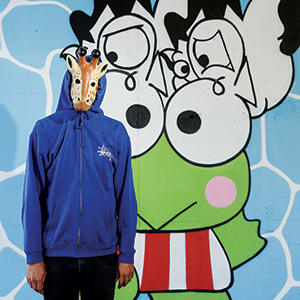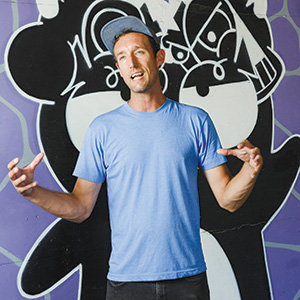Two years before he was arrested for emblazoning walls, box trucks, train cars and freeway overpasses all over the Bay Area with his signature black and yellow giraffe character, Steven Free—better known by his graffiti moniker, Girafa—found himself staring down the barrel of a gun.
It was a cool San Francisco night sometime in 2007, and Free was on the roof of a building in the SOMA district, preparing to paint a large wall overlooking a nearby stretch of freeway. He heard footsteps and turned to find a man training a flashlight on him. Time to go. Free headed back the way he’d come—down a fire escape.
Thin and nimble, Free had eluded police and security guards before. But he wasn’t quick enough on this night. As he continued his descent, hanging onto the outside of the fire escape’s railing, the man with the flashlight emerged from a door on the same level as the fleeing artist. This time Free saw that he had a gun.
“I was like, ‘Oh, shit,'” Free says. Forming a pistol with his forefinger and thumb and holding it to his temple. “He put the gun right up against my head. I felt it. It was cold. It felt heavy. I knew it was real.”
He began apologizing profusely. “I’m sorry! I’m sorry!” Free recalls telling the man, whom he believes may have been the building’s owner. But his pursuer was having none of it. “He started cracking me on the head with his flashlight.”
Looking back, it’s all a blur, but Free still remembers how time seemed to stop in the moment. With a hint of embarrassment, he notes how “cliche” it is to say that his life flashed before his eyes. “But it’s so true.” His mind raced as he thought about everyone he loved and all the things he would miss. And then
“I just dropped.”
Free estimates he fell about two or three floors, landing feet first on the street below before collapsing flat on his back. Looking up, he saw the man pointing the light and gun back down at him. Free sprang to his feet, somehow unscathed, and sprinted away—not back to his car or his home in the South Bay, but off to another spot so he could pick up where he had left off.
As he recounts the story over coffee at Roy’s Station in San Jose’s Japantown, just a short drive from his apartment and art studio, Free shakes his head at the memory of how unfazed he was by the incident. Then again, addicts always find a way to rationalize their behavior. And just like an alcoholic smoothing out a hangover with a good morning Bloody Mary, Free says he wasn’t about to let a brush with death keep him from his fix.
The graffiti lifestyle, and the praise it won him online, had him hooked. In fact, Free says, being Girafa was so intoxicating that it was easy to move on to the next wall, the next overpass, the next train yard and keep painting—consequences be damned.
Body of Work
Free says he doesn’t paint anything without permission these days. Still, much of his illicit work as Girafa remains in place—from San Jose, up to San Francisco, over to Oakland and back down. His art can be found on the walls of industrial buildings, plastered across fences facing railroad tracks, on the backs of big rig trailers and on the cement banks of flood control channels. He estimates he put up more than 1,000 pieces in his heyday.
Over a four-year period starting in 2005, Free painted variations of his signature black-and-yellow character and “Girafa” bubble letters all over the Bay Area. And people took notice. Fans of his work started documenting his pieces, putting them up on Flickr and social media, where the works were applauded in the comments section.
Like Banksy and Shepard Fairey, Girafa became more than just a street artist. He was a guerrilla Don Draper. He put half a decade into tirelessly marketing his brand on the streets, using many of the same strategies professional advertising agencies use to create a unique identity for a client, like sticking to a defined palette and being deliberate about placing his pieces in high visibility areas.
The more attention Girafa garnered, the more local law enforcement agencies sought to shut him down. His parents were aware for some time that the boy they had raised was Girafa, but they didn’t understand the extent of it until the day his mother saw an ad placed in a local paper. The Milpitas Police Department was offering a cash reward for information leading to Girafa’s capture.
“‘When they get you, they’re gonna get you good,'” the artist recalls his mother’s words of warning. At the time, he wasn’t concerned. In fact, he viewed the reward as a badge of honor.
A Portrait of the Artist
At the apex of his street art career, Free never gave much thought to the dangers of being Girafa, nor how his upbringing and personal baggage might have influenced the decisions he was making.
Growing up, Free was never quite sure who he was as an individual. He is an orphan and the man and woman he calls “dad” and “mom” are not his biological parents. As he tells it, his biological mother abandoned him when he was three years old.
“I think, in the back of my head, I’ve always carried that with me,” Free says. “At the time, I felt worthless. My own birth mom kind of just threw me out. Graffiti kind of filled me up. It made me feel like I am special. I am worth something.”
Raised in a loving yet strict household, he says his family kept him on a tight leash and he seldom got a chance to go out. Not that he would have been a social butterfly if things were different. Free says he has always been an introvert.
Whenever his parents did allow him out of the house, the young Free would almost always spend it the same way. He would run down to the local comic book store to pick up a book—his favorite was Wolverine—and beeline it back home. Upon returning from these brief pilgrimages he would lock himself in his room and pore over the recent additions to his collection, reading his latest acquisition from cover to cover and then attempt to recreate a page or two, frame-by-frame.
His childhood pastime clearly helped to shape what the young Free would become. Not only did the hours he spent copying pages out of comics teach him how to draw, the books also provided instructions on how to live a dual life. After all, every superhero has an alter ego—many of them timid, polar opposites to the gregarious, powerful beings behind the masks…




